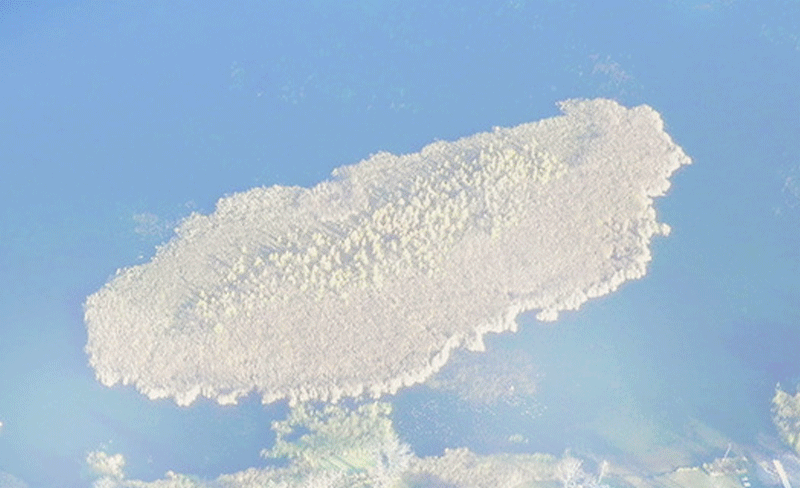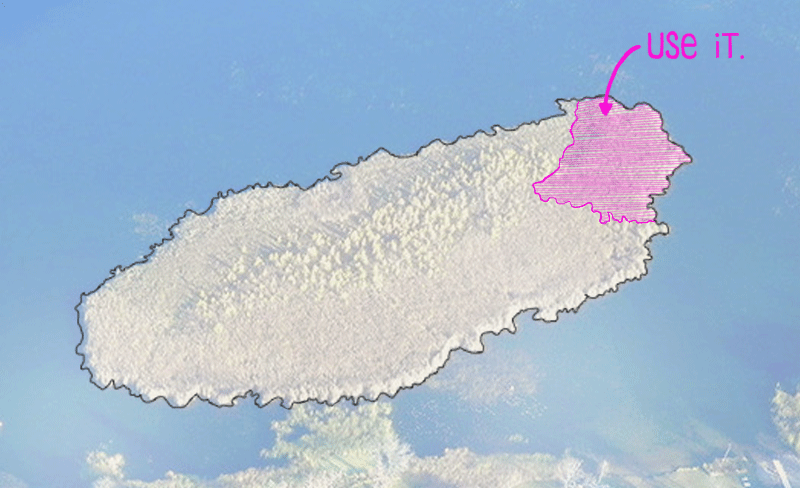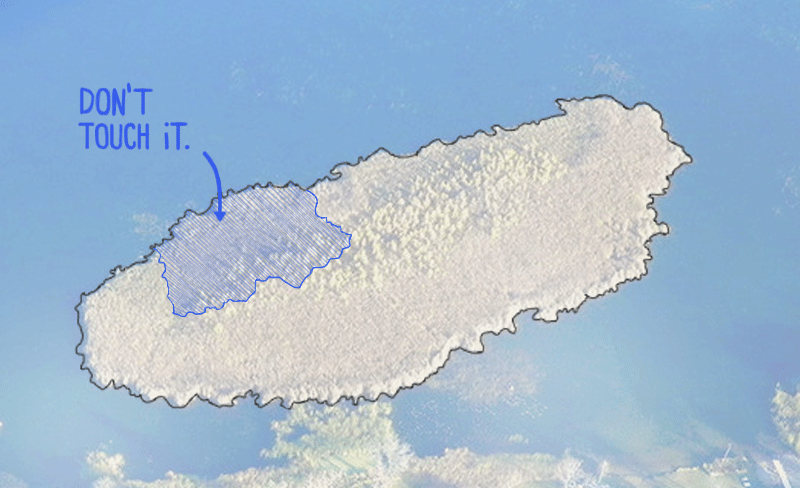Your Best Ideas for Dealing With Minnesota’s Rogue Bog
Atlas Obscura readers offer creative solutions to a floating menace.

In May, Randy Tesdahl, of the American Legion in Minnesota, is hoping to chain and tow a massive floating bog. The bog in question has been moving around North Long Lake for months now, creating all sorts of havoc for local residents. The four-acre tonnage of plants and peat has crashed through residential docks and destroyed boat lifts during its travels, and at this point, something needs to be done.
Tesdahl’s plan (read all about it here) to relocate what’s been dubbed the “Great Beast of North Long Lake” to a more permanent, safer home is as ambitious as it is homegrown. Will it ultimately work? Minnesotans will have to wait a bit longer before they find out. In the meantime, we asked Atlas Obscura readers to send us their ideas for how to deal with the rogue bog, no matter how outlandish.
Our readers suggested a wide and wild variety of solutions to the problem of a dangerously floating bog. Some dreamed up complex plans to move it to a different location; others were in favor of destroying it. An overwhelming number of respondents want to use it to create whiskey. Oh, and then there were those who want to worship it.
We received hundreds of responses and can’t share them all, but we’ve compiled our favorites below.
Science It
“Use a tug boat or motorized craft to pull the bog into a particularly polluted waterway or body of water, to use for heavy metal or pollutant remediation. The plant life (rhizomes are adept at metal uptake) of the bog can be used to filter shorelines and the peat can then be processed and recycled or burned/contained. The floating bog can be replicated and used for wetland remediation.”—N.M. Bulger, Buffalo, New York
“Take it apart with a dredge. You could also winch/anchor it to the shore, and take it apart using an excavator.”—Erik Lindroth, Brainerd, Minnesota
“Anchor it in shallow water and attach it to natural barriers (natural ports) that are heavy in vegetation so that they can act as a natural anchors. The introduction of trees (non-invasive and indigenous) with deep roots could be implemented on the island so that they can anchor their roots in the shallow waters and the island will gradually secure itself there. Another option would be identifying the wetland areas, in the high rain season when the wetlands are flooded the floating island can be transported (floated) high inland and anchored there. When the water is low, the island will settle down on the ground where it can be permanently secured away from the main river stream.”—Bernard Carabott, Malta
“I’m not an engineer, nor an environmental specialist. I wonder about the feasibility of breaking it up, grinding it down and composting it over time? The compost could then be sold for local benefits, and shoreline improvement projects? Of course I’m not sure what removing it altogether would do to the lake’s ecosystem either.”—Shane Spencer, Carmichael, California
“Can’t destroy it. Find a bay if possible, find out prevailing wind direction, put in a spot where it’ll likely stay. Anchor it in place with concrete pylons/telephone poles on the edge of the bog, 15 feet apart. If engineers can sink concrete pylons for a megabridge in a river, they can anchor a floating bog raft in place.”—Dan, Minneapolis, Minnesota
“Surround and or cover the bog with a net which is tethered in multiple places to the lakeshore and poles can be driven through the bog into the lake bed. The live elements of the bog will grow through the net, maybe even reintegrating with the shore in time. The spacing of the mesh and the type and shape of the material used would have to be researched to avoid creating a trap for wildlife and lake users. Reintegration with the shore could be assisted by the planting of selected deep root vegetation.”—Ian Mann, Australia
“Concrete blocks and long cables to anchor it in a desired location to create waterfowl nesting habitat.”—Vincent Butrock, Seattle, Washington
“Dump tons of lime on it to increase the pH drastically, and it will die.”—Bill Cabrera, Pennsylvania

Use It
“Getting the community together to help take care of this thing is the way to go. Maybe make an event out of it. People cooped up all winter long are itching for something fun to do. Have bounce houses, food, games, etc. and invite anyone and everyone to come out and hack it up into smaller pieces. Have prizes even for biggest piece removed, most creative way to remove it, the most weight, etc. A lot of smaller pieces are easier to deal with than one giant one. Once removed from the water, you can haul it away some place it will no longer cause a threat.”— Janine Caswell, Syracuse, New York
“Attach some anchors to it and plant it in the middle of the lake because it seems like there are no islands there. Build a small house and turn it into a state park or nature reserve. Maybe just have one anchor so it’s just spinning on an axis slowly and peacefully. I’m thinking of those rotating houses. Having an entire island that rotates could be really peaceful and cool.”—Daniel Cerrato, Peekskill, New York
“Declare it a micronation: Bogland. Anchor it to the center of the lake, issue visas to visitors/tourists. Sell souvenirs and donate money to the local people affected by the bog.”—Mehdi Rizvi, Italy
“You know how music festivals always leave the land they’re on totally destroyed at the end of the weekend? It gets so bad at Glastonbury that they have to take an off year every now and then to let the land recover. Minnesota should arrange a super exclusive, luxury music festival to take place on the floating bog. Invite a bunch of wealthy tech bros and Instagram beauty bloggers and charge $10,000 a head! Give the money to the community to repair the damage that the bog created, then once all the rich boring people are done listening to the Red Hot Chili Peppers or whatever, the bog will naturally dissolve from the havoc wreaked by the festival-goers. Still better than Fyre Fest, probably.”—Suze, New York City, New York
“Many goats with water wings so they can concentrate energy on eating. Recorded dog barking on shore to keep the goats in the bog.”—Daryl Hallquist, Montana
“It sounds like the bog is large enough that it would support human activity on top of it. My idea? Attach a floating dock to it and build temporary structures on it as a showcase for housing and buildings in flood-prone areas, or where building conditions are unstable. Have a “pop-up” food stand there and let people wander the island and look at different sustainable temporary building solutions, and run a ferry service from Brainerd (a summertime tourism destination in MN) up to see it. Use this unique situation to showcase building solutions for more common problems.”—Moshe Baruch, Saint Paul, Minnesota
Fertilize It
“Scoop it up. Compost it. Donate the compost to community gardens.”—Pat, West Virginia
“If I understand correctly it is a peat bog. Peat is a much sought after gardening material. Harvest it, bag it and sell it. If that’s not practical, contact a company that does retail peat and offer it to them.”—Earle W., Southern New Hampshire
“Bag it. Sell it. ‘Own a Piece of the Rogue Bog!’”—Bradley Norris, Texas
Drink It
“Harvest peat. Malt barley using dried peat smoke. Start an American whiskey distillery. Name it “Rogue Bog.” Give me 10 percent ownership stake as a thank you.”—Dan, Seattle, Washington
“Having lived for 17 years in Minnesota, I’m very familiar with the beauty of the land, and the plentiful excellent fresh water. But the state (as well as the rest of the U.S.A.) is without a quality U.S. produced single malt scotch. That’s right, this is where the peat comes in. Some enterprising individual should seize the opportunity to build a distillery for the purpose of producing a fine Minnesota single malt. The bog should be contained, preferably by means of a collar, similar to those containing oil spills. Once harnessed and secured, the peat can be harvested, and combined with the excellent local water. World-class malt can be found literally next door in Canada. The result would be Glen North Long Lake Single Malt Whiskey.”—Larry Snider, Melbourne, Florida
“Tow it to the top of an out-flowing stream and wedge it there. Build a distillery downstream and use the peaty water to make whiskey. Sláinte!”—Jim Wright, Toronto, Canada
“Cut it up—ask the peat cutters of Ireland and Scotland for advice—then use the peat to improve gardens, dry it out and chuck it into the locals’ log burners for free fuel. But most importantly make sure they keep a good bit back to make a fine smokey whiskey called ‘Wild Beast.’ Sell the whiskey to cover the costs of getting rid of the bog!”—Anjuli Atterby, London, England
“If the bog is truly peat, use a group of boats and cut the bog into narrow strips that can be pulled out of the lake onto the shoreline. Let these strips dry then load them onto trucks. These trucks can transport the peat to Lake Superior where they can be loaded onto ships and sent to Scotland. Auction the peat to Scotch distillers who could distill a batch of American Peat Scotch! It will take a few years, but the distillery will have a unique product, sure to sell in Minnesota!”—Kurt Morine, Wisconsin

Don’t Touch It
“To destroy it would be an absolute sin against the planet we live on! Move it to an uninhabited part of the lake and away from shore then anchor it. We can build bridges, skyscrapers, etc. but I am sure someone can come up with an inexpensive way to anchor this natural wonder. If I owned one of the docks it ate, I would sit out with a glass of wine, watch the scene, smile, and say go for it. Who knows what life and secrets it holds?”—Scott Farmer, Portland, Maine
“As funny as this problem seems, the bog is, after all, a floating habitat. There are all sorts of critters living in the peat, from bacteria and other microscopic biota to insects and rodents, on up to birch trees and grasses. Peat is a living organism in itself and not much new peat is being created in the modern world. I think that Randy Tesdahl has the right idea: pull the bog/raft away from habitated shoreline and stake it down. Sure blowing things up is fun, but helping to create and maintain a living entity is better than destroying something. Right?”—Cindy Rose, Wyoming
Destroy It
“Peat burns. There have been fires in Georgia and Florida for as long as I’ve been reading newspapers (a pretty good while now). A controlled burn might break up this big clump of decaying organic matter, and release the dirt attached to it!”—Carol, South Carolina
“Bring it to a boat landing, start chopping it up and loading it onto a dump truck with some bobcats. Remove it in pieces. Minnesota people are great for helping and working together.”—Jet Black, Minnesota
“Harness 10,000 mallards to the water side of the island, cover the island with a giant range hood, hook the range hood to a piece of flex hose, light the peat bog on fire, capture the heat and smoke produced under the range hood, turn the range hood fan on high and direct the end of the flex hose toward the ducks. The ducks will attempt to paddle away from island, towing it behind them. The island will eventually burn itself into oblivion. Apologize later for the smoke and CO2. Reward ducks with Minnesota’s thoughts and prayers and a huge military parade (with flyover).”—Jay Hayden, Rube, Montana
“Nuke the entire site from orbit. It’s the only way to be sure.”—Michael, Toronto, Canada

Worship It
“Clearly we should tie people up and deposit them in the bogs as offerings to the gods of fertility and good fortune.”—Mason, St. Louis, Missouri
“Embrace The Bog.”—Dee, Alberta, Canada
“Allow it to eat everything in its path and come to appreciate and worship its mysterious and destructive ways. It’s 2018—why not let a naturally-occurring metaphor just work as God intended?”—Sarah, St. Louis, Missouri
“I would hug it, maybe it just wants a friend.”—Ben Duursma, Bishop’s Stortford, England
Um… Other?
“Attach an outboard motor.”—Joe, Chicago, Illinois
“Everyone already suggested all the cool stuff like blowing it up, but did anyone stop and consider what the people of the bog want? Now I’m just a humble man who lives on the bog and relies on its movements for convening with lake spirits. A stationary bog makes this impossible because everyone knows the lake spirits can only do their dance macabre untethered from this world. Plus, every so often the floating peat releases gases that smell like human flatulence and the spirits are drawn to the smells. I’m inclined to just let floating bogs lie, docks be damned.”—Bog Man, Floating Bog, North Long Lake, Minnesota
“Has anyone tried reasoning with the bog?”—Nick Leitzen, Maple Grove, Minnesota
“I’d live on it and become captain and protector of battleship bog.”—Ian, Texas
“Move it to a place where it can be viewed and anchor it, then sprinkle by air, millions of flower seeds and allow it to become a beautiful floating ‘Flower Island.’ It will be seen by millions and people from all around the world will say, ‘What a beautiful island.’ Make it something to be proud of.”—Jay Dunning, Perth, Western Australia
If you have an idea of your own to share, head over to our community forums and tell us about it!
Responses have been edited for grammar and clarity.


























Follow us on Twitter to get the latest on the world's hidden wonders.
Like us on Facebook to get the latest on the world's hidden wonders.
Follow us on Twitter Like us on Facebook